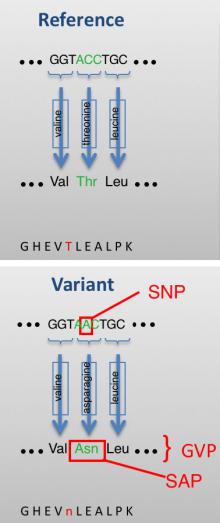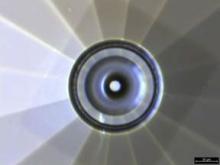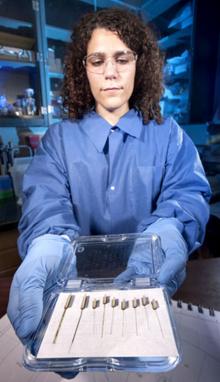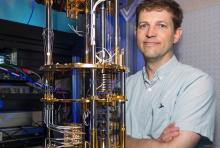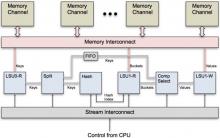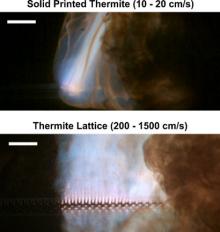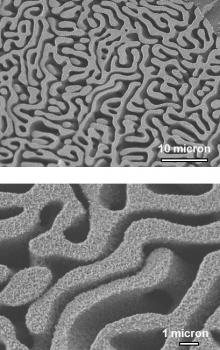This section provides a sampling of research projects from this year's portfolio, representing a range of categories and various stages of completion. For reference, project numbers that begin with 16 were launched in 2016 and are now complete; those beginning with 17 or 18 were launched in 2017 or 2018, respectively, and are most likely continuing.
Project: Forensic Science of Genetically Variant Peptides | 16-SI-002
Principal investigator: Bradley Hart
Mission or competency: nuclear threat reduction; forensic science
Executive summary: To address major gaps in forensic science, researchers have developed an entirely new approach to human identification that does not rely on DNA
The primary goals of this effort were to develop the foundational science to enable high-fidelity proteomic analysis of hair samples. Human hair contains minimal intact nuclear deoxyribonucleic acid (DNA) for human identification in forensic and archaeological applications. In contrast, proteins offer a pathway to exploit hair evidence for human identification, owing to their persistence, abundance, and derivation from DNA. (i.e., Proteins are chemically more robust than nuclear DNA, and although people do not inherit proteins, they do inherit the DNA that produces their proteins.) Researchers identified variants in proteins resulting from amino acid substitutions that stem from DNA mutation. These variants, known as single amino acid polymorphisms (SAPs), can be used together to generate identifying information about an individual, either in modern forensic or in bioarcheological contexts.
The research conducted in this project has established an entirely new approach to human identification that does not rely on DNA. Furthermore, though the focus was on high-fidelity proteomic analysis of hair samples, the research team has already adapted these methods for use in analyzing bone samples. Often bone is the only remaining human material available to a forensics investigator or bioarcheologist.
Mission Impact: One possible important application for using protein markers from human bones could be to help determine the identity of partial remains from catastrophic events, such as plane crashes, fires, or the 9/11 terrorist attacks. This novel forensic method can also be extended to other security contexts, including counterproliferation, counterterrorism, and homeland security.
Project: Investigation of Ultrahigh-Pressure Phase Transitions in Metals with a Toroidal Diamond Anvil Cell | 17-ERD-038
Principal investigator: Zsolt Jenei
Mission or competency: high-energy-density science
Executive summary: Using newly designed diamond anvil cells, researchers are providing high-accuracy equation-of-state data for metals under extreme pressures and developing new experiment-based understandings of the physics driving material transitions.
The diamond anvil cell, which has been around for over 50 years, has been the primary tool for routinely studying materials up to pressures of about 3 million atmospheres. Static pressures exceeding 4 million atmospheres are extremely challenging to achieve—and experiments reporting these pressures are rare—but they are necessary for the study of matter that exists under these conditions in natural environments, such as planetary interiors. As described in a recent paper published in Nature Communications, a team of researchers has demonstrated that a diamond anvil with a toroidal profile is capable of sustaining pressures of over 6 million atmospheres. In their design, the toroidal profile prevents gasket overflow and provides a means to stabilize the central cutlet, allowing a maximum pressure previously accessed only by double-stage diamond anvils and dynamic compression platforms. This optimization of single-crystal diamond anvil design is key in extending the pressure range over which studies can be performed in the diamond anvil cell.
Mission Impact: This research supports nuclear stockpile stewardship science and high-energy-density science by expanding capabilities at the leading edge of static high-pressure science and providing validated tools for measurement of materials of interest. This technology has applications to DOE missions in science, energy, and nuclear security.
Project: The Engineered Micro-Sensor Array | 16-ERD-035
Principal investigator: Anna Belle
Mission or competency: bioscience and bioengineering
Executive summary: Researchers have developed a first-of-its kind chemical sensor platform that will allow for the long-term study of the body's response to bio-agents and drugs.
Biological systems communicate and function through a series of complex biochemical and electrical interactions. The ability to monitor these diverse interactions in real time and in physiologically relevant settings can be a powerful tool in determining the biological causes of diseases and uncovering the mechanisms underlying the body's response to chemical agents. While there are abundant electrical recording instruments, there are few chemical recording platforms. This is despite the fact that only a fraction of the body's signaling mechanism is electrical and the majority is biochemical. Over 500 quadrillion chemical reactions occur in our bodies each day. The goal of this project was to provide a fundamental understanding of the body's response to bio-agents and drugs by developing an advanced chemical-sensor platform. A team of scientists and engineers have developed individual sensors to monitor cell health by measuring multiple biomarkers simultaneously, in real time. They first created a sensor array and the recording instruments needed to build this advanced sensor platform. Then they addressed the problems of sensor lifetime by using a novel technique of chemically engineering enzymes with nanometer-scale complexes that improve enzyme stability. To improve sensor sensitivity, they custom engineered strings of nucleotides to specifically recognize complementary strings of nucleotides on target proteins of interest and also increased the electrode sensing interface with a custom roughening technique. Finally, they enhanced the fabrication of the electrode arrays by incorporating carbon-based materials into the micro-fabricated array platform, thereby opening the possibilities for new sensor methods on the platform. As a result, this platform allows, for the first time, the long-term study of the acetylcholine neurotransmitter system affected by nerve agents and open doors to sense protein-based biomarkers important to monitoring immune response. It also makes nondestructive chemical sensing accessible to the two- and three-dimensional biomolecular platforms that will be commonplace in the near future.
Mission Impact: These chemical sensors are a rapid, nondestructive method for monitoring cell health that enables the development of countermeasures against biological and chemical threats. These sensors can also be modified to enable electrochemical detection both in a clinic and in the field.
Project: Enhanced Coherence for Quantum Sensing and Simulation | 16-SI-004
Principal investigator: Jonathan DuBois
Mission or competency: advanced materials and manufacturing; cybersecurity and cyber-physical resilience
Researchers have developed a robust capability to design, fabricate, characterize, and optimize the performance of quantum coherent materials and devices for applications in sensing, analog quantum simulation, and quantum computing. The team has also made significant contributions to the understanding and amelioration of noise sources in superconducting quantum circuits, developed and implemented the skill sets required to design and fabricate novel quantum sensors and quantum computing devices, and formed strong partnerships with leading groups in academia, industry and other national laboratories to further the development and application of quantum devices and materials. The key technical accomplishments resulting from this project include the following:
- establishment of world-class quantum materials and quantum computing testbed laboratories
- development and testing of novel quantum computing architectures optimized for near-term applications in scientific quantum computation and simulation
- demonstration of novel applications of advanced manufacturing methods for quantum sensing and materials
- development of new quantum sensing platforms designed to probe the materials sources of quantum decoherence in quantum devices
- demonstration of a multiplexed readout of cryogenic detectors for high-resolution spectroscopy
- discovery of new quantum materials properties in topological insulators (TI) and emergent superconductivity in composite TI and normal metal structures
- realization and application of a novel control-centric approach to efficient realization of quantum algorithms on current and near-term quantum computing hardware
Mission Impact: This research developed new approaches to applying quantum coherent systems to NNSA mission-relevant computational challenges. Future development of quantum computing and simulation has the potential to dramatically impact the nation's stockpile stewardship program through improved computational fidelity and efficiency. Continued research focused on co-design of quantum hardware and hardware-aware quantum algorithms is now sponsored by the DOE Office of Science Advanced Scientific Computing Research (ASCR) under the "quantum testbed pathfinder" program, as well as the NNSA's Advanced Simulation and Computing (ASC) program under the "Beyond Moore's Law" program.
Project: In-Memory Associative Indexing: An Approach to Efficient High-Performance Computing |
16-ERD-005
Principal investigator: Maya Gokhale
Mission or competency: high-performance computing, simulation, and data science
Executive summary: Researchers have developed hardware modules that address a long-standing, memory-bottleneck problem in high-performance computing. This novel approach to memory creates efficiencies in performance and energy use, supporting the large computational tasks that underpin many NNSA missions and the design of future exascale architectures.
The memory wall—the growing disparity of speed between a central processing unit (CPU) and the memory capacity outside the unit's chip—is perhaps the most prominent obstacle to processing expanding volumes of data. While technological improvements continue to increase the number of processing cores on a chip, improvements in memory bandwidth (i.e., the rate at which data can be read from or stored in a semiconductor's memory by a processor) and memory latency (i.e., the time between initiating a request for a byte in memory until it is retrieved by a processor) at the equivalent scale are not forthcoming, resulting in teraflop-sized supercomputer cores that must sit idle while waiting on data input. If the data are not in the processor's cache, it takes longer to obtain them because the processor will have to communicate with the external memory cells. It is a continuing challenge to keep the CPU cores doing useful work because memory-bandwidth improvements such as high-bandwidth memory mainly benefit regular, streaming access patterns.
A team of researchers addressed the issues of memory latency, bandwidth, and computational power for associative-indexing applications by incorporating key-value store search capabilities into the memory itself. Commonly employed in data science and simulations, particularly in scientific computing that incorporates sparse data structures, this associative-indexing technique is used in search methods wherein data is accessed by content rather than directly accessed by the memory address where the data is stored. The team designed, prototyped, and evaluated a key-value store lookup accelerator optimized for in-memory search. Incorporating logic with memory has become feasible with the emergence of three-dimensional memory stacks that put a memory controller in a base logic layer. In contrast to conventional key-value search accelerators that embed CPUs in the memory, this novel approach created a customized hardware pipeline in the memory itself to search the key-value store. This memory-based accelerator outperformed conventional key-value store search by as much as twelve times. The team evaluated the use of the accelerator in future memory systems using hardware-based emulation.
Mission Impact: This research is highly relevant to DOE post-exascale architectures, addressing the memory access bottleneck through research into specialized acceleration functions for scalable compute-node performance improvement. Also, this project resulted in a patent for a near-memory data reorganization engine.
Project: Controlling Detonative Phenomena with High-Explosives Material Architecture | 16-ERD-040
Principal investigator: Alex Gash
Mission or competency: high-explosives physics, chemistry, and material science; advanced materials and manufacturing
Executive summary: Researchers developed novel fabrication techniques using dynamic characterization and modeling to capture the unique behavior associated with microscopically designed high-explosive materials. Results enable innovative concepts for surety of stockpile modernization and provide novel energetic material solutions to challenges relevant to conventional defense.
Researchers investigated the application of three-dimensional material printing (3DP) to energetic materials (e.g., explosives and pyrotechnics). The initiation and energy release properties of these materials can be highly dependent on the materials' micron-scaled structure and composition. Conventional energetic materials processing provides no engineering control of material architecture on this length scale. Selected 3DP techniques do provide engineering control at the scale of 10s–100s of microns, which enables a new parameter to the control of performance and safety characteristics. The team developed custom 3D-printable energetic feedstocks and used 3DP techniques to fabricate energetic materials with material architectures that were engineered to have spatially modulated density, structure, and or composition. This approach allowed the systematic investigation of the influence of these characteristics on the initiation and energy release properties of both pyrotechnics and explosives. This development enabled the correlation of select material architectures of a pyrotechnic for energy release rate and linear combustion velocity, as well as substantial control of those properties. For the field of high explosives (HE), this study demonstrated that discreetly placed localized aluminum powder can augment the pressure profile and detonation reaction to lengthen and shift the secondary pressure peak observed in aluminized explosives. Finally, this study showed that topology optimization and engineering of the material composition of the interface between two explosives using 3DP methods is a new and viable tool for engineering the performance of energetics.
Mission Impact: This project supports national goals in stockpile stewardship and national security while enhancing the Laboratory's advanced manufacturing capabilities. Specifically, the manufacturing methods developed during this project will enable a more detailed understanding of new energetic material architectures, which will support a more innovative design process for components, leading to improvements in the performance, safety, and precision of both the nuclear and conventional stockpiles.
Project: Hierarchical Nanometer-Scale Porous Copper Flow-Through Electrodes for Efficient Carbon Dioxide Reduction | 17-LW-013
Principal investigator: Monika Biener
Mission or competency: energy and resource security; advanced materials and manufacturing
Executive summary: researchers developed novel copper membranes with nanometer-scale surface features with which to build electrodes that will function as catalysts in the reduction of carbon dioxide.
Researchers explored a flow-through electrochemical reactor design for high-power-density applications. They used pressure-driven mass transport of reactants through bulk porous electrodes to overcome mass-transport limitations and exploit the large internal surface of the designed electrode materials. Preferably, the flow-through working electrode has a hierarchical pore morphology: Large pores warrant fast mass transport through the electrode at relatively low pressure differentials across the electrode, and small pores provide the high surface area necessary for achieving high conversion rates for even low reaction probabilities. Unlike flow-by electrolysis setups, the reactant stream is continuously moved through the porous catalyst electrode. The team's experiments show that flowing electrolyte solution directly through the electrode increases the CO2 reduction-related current; however, the effect is small in aqueous electrolytes, owing to the dominance of the competing hydrogen evolution reaction.
Mission Impact: This project advances the DOE goal of delivering tools that support a more economically competitive, secure, and resilient energy infrastructure and addresses LLNL's energy and resource security research and development challenge by providing a pathway to efficient CO2 capture via oxidative reduction to hydrocarbons using excess energy from regenerative power sources. This research also strengthens the Laboratory's core competency in advanced materials and manufacturing by adding new material synthesis and characterization capabilities. This was the first project at LLNL on electrocatalytic conversion of CO2 to fuels, which is now a key component of the Laboratory's carbon initiative. It provided the seed for several larger funded projects in this field, including a cooperative research and development project.


